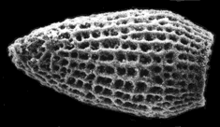Polycystine
Appearance
| Polycystine | |
|---|---|

| |
| Skeleton of a polycystine | |
| Scientific classification | |
| Domain: | Eukaryota |
| Clade: | Diaphoretickes |
| Clade: | SAR |
| Phylum: | Retaria |
| Subphylum: | Radiolaria |
| Class: | Polycystina Ehrenberg, 1838, emend. Haeckel, 1887 |
| Orders[1] | |
The polycystines are a group of radiolarians. They include the vast majority of the fossil radiolaria, as their skeletons are abundant in marine sediments, making them one of the most common groups of microfossils. These skeletons are composed of opaline silica. In some it takes the form of relatively simple spicules, but in others it forms more elaborate lattices, such as concentric spheres with radial spines or sequences of conical chambers.

References
- ^ WoRMS (2019). Polycystina. Accessed at: http://www.marinespecies.org/aphia.php?p=taxdetails&id=235740 on 2019-01-08
External links
 Data related to Polycystinea at Wikispecies
Data related to Polycystinea at Wikispecies- "Systematics of the Radiolaria".
- Radiolaria.org
- "Polycystine radiolarians".
